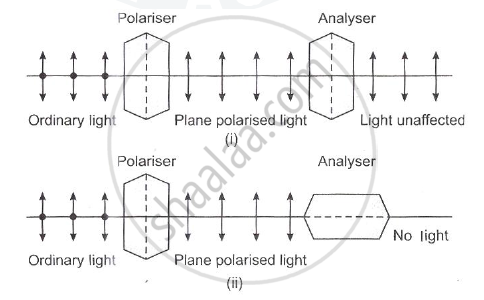Advertisements
Advertisements
Question
With the help of an experiment, state how will you identify whether a given beam of light is polarised or unpolarized?
Solution
Detection of plane polarised light: Naked eyes or the polarizer alone cannot make the distinction between unpolarised light and plane polarised light. To analyse the nature of light, another crystal (analyser) is used. The tourmaline crystal is used to produce plane polarised light.
If the polarizers rotated in the path of the ordinary light, the intensity of the light transmitted from the polarizer remains unchanged. It is because, in each orientation of the polarizer, the plane polarised light is obtained, which has vibrations in a direction parallel to the axis of the crystal in that orientation. If the analyser is rotated in the path of the light transmitted from the polarizer,so that the axis of the polarizer and the analyser are parallel to each other, then the intensity of light is found to remain unaffected [see figure].
If the axis of the polarizer and the analyser are perpendicular to each other as shown in the figure, then the intensity of light becomes minimum
In this position, the polarizer and the analyser are said to be in crossed position.

APPEARS IN
RELATED QUESTIONS
With the help of neat diagram, explain how non-polar dielectric material is polarised in external electric field of increasing intensity. Define polarisation in dielectrics.
Why does an unpolarised light incident on a polaroid get linearly polarised ?
What is the value of refractive index of a medium of polarising angle 60°?
A beam of light is incident at the polarizing angle of 35° on a certain glass plate. The refractive index of the glass plate is :
Green light is incident at the polarising angle on a certain transparent medium. The angle of refraction is 30° . Find
(i) polarising angle, and
(ii) refractive index of the medium.
What is a polariser?
What is a analyser?
State Brewster’s law.
What is the angle of polarisation and obtain the equation for an angle of polarisation?
Can reflection result in plane polarised light if the light is incident on the interface from the side with higher refractive index?
